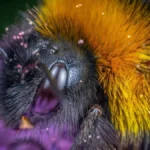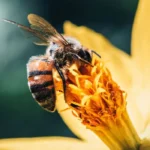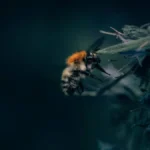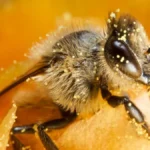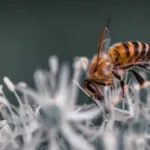In this article, we take a look at the hairs on bees and answer the question “do bees have fur?”. Short answer – no – but they do have hairs on their body. Long answer – the rest of this article.
What Is Fur?
If we want to really be super definition compliant, fur is fine hair that is short and soft and dense and grows on the skins of animals.
From this we can see that bees cannot really have fur, as they don’t have skin – they have an exoskeleton.
Bees do however have hairs on their body, and they look furry when they are young. Let’s go into what these hairs are and how they work.
Do Bees Have Hair?
Yes, they do. Bees have both straight hairs and plumose hairs. A plumose hair is branched and looks a bit like a feather. The plumose hairs are important in allowing the bees to collect pollen (and pollinate flowers). Straight hairs are more important for sensory reasons.
Why Do Bees Have Hair?
When a bee lands on a flower, the hairs covering its body trap pollen. The bee collects this pollen and packs it into its pollen basket. A few grains of pollen may with luck be moved around the flower, or from one flower to another, allowing pollination.
Hence the main reason bees have hair is for pollen gathering. This pollen is an important nutrient source for the bees. Pollen is rich in proteins, carbohydrates, fats, vitamins, and minerals.
As we have mentioned, straight hairs are important for sensory reasons, allowing bees to sense vibrations, navigate, feel other bees, and so on.

Learn more about: How Do Bees Get Pollen From Flowers?
Do Honey Bees Have Hair On Their Eyes?
Yes, they do! The function of the hairs on the eyes is mainly to stop pollen from touching the eyes. The front legs of the bees have a special hair comb section that allows them to keep their eyes free of pollen.
Bees land on flowers and start rummaging around inside the flower. The pollen granules can cover the eyes rapidly, which reduces the bee’s ability to see. They have a very specific action they perform with their front legs to clear the eyes. The hairs on the legs are able to penetrate deep into the hairs covering the eyes and remove even small grains of pollen.
As we have seen in this article bees have compound eyes. The bee uses the compound eyes for navigation and it is relatively important that the largest surface area of the compound eye is unimpeded by pollen. The removal of pollen granules is important, and also allows the bees to achieve the maximum pollen harvest rate from the flower.
What Happens As Bees Get Older?
As a bee works, the hairs on her body encounter wear and tear. This reduces their density, as hairs break, or get thin and broken. I have watched bees that are clearly old working on flowers and their bodies are polished nearly clean. The repeated removal of pollen results in the bee losing hairs and eventually she first goes bald on the back of her thorax, and gradually her whole body.
I have seen bees that were polished nearly entirely over their whole body. Even their corbicula (pollen baskets) were scraggly and had few hairs left. There are certain flowers that have thorns close to the flowers that seem to cause increased wear on the bees.
What Is Pollenkitt and How Does It Interact With Bee Hairs?
Pollenkitt is a sticky substance that coats most angiosperm pollen. This material helps to stop pollen blowing away in the wind, or washing away in rain. It also helps pollen adhere to pollinators who carry the pollen to other flowers.
For bees, pollenkitt really helps them to form a nice tight pollen basket packing. They need to be able to carry the largest load of pollen from the flower to the hive – pollenkitt allows them to do this.
At certain times of the year, bees may become pollen starved and collect pollen from wind-pollinated grasses such as maize. I have actually watched bees do this and you can see that the maize pollen does not form a tight pellet in the pollen basket. Being a wind-pollinated plant, maize needs its pollen to blow freely in the wind and not be very sticky.
Allergy To Bee Hair?
Bee hair breaks off and can end up on your hands when you work with bees. When you rub your eyes or nose, their hairs penetrate the thin skin and membranes entering the bloodstream. With time your body can mount an allergic response to this.
You will see a person with a bee hair allergy will often develop hay fever-like symptoms an hour after working the bees. With time this allergy will normally pass and fade away. It is however very irritating when you first develop it. I have had it, and have watched some of the people I trained as beekeepers develop the allergy.
If you do develop this allergy, visit your doctor who will prescribe an antihistamine – I found that Telfast 180 helped. It also helps if you do not rub your eyes, and wash your hands with soapy water after working the bees. This helps to remove the hairs and stops you from getting them into the soft tissues in your eyes.
I hope this article has helped explain answer the question “Do bees have fur” and how bee hair works! If you enjoyed it, please share. And remember, bees have hairs on their eyes, but if you get those hairs in your eyes it itches!!
Honey Bee Fuzz FAQs
Do bees have fur?
No, bees do not have fur. Instead, they have fine hairs covering their exoskeleton. These hairs help bees collect pollen and sense their surroundings.
Why do bees have hair?
Bees have hair primarily to help with pollination. Their hairs trap pollen as they visit flowers, allowing them to collect and transfer pollen between plants.
What types of hair do bees have?
Bees have two types of hair: straight and plumose (feather-like) hairs. Plumose hairs are especially useful for trapping pollen, while straight hairs aid in sensory functions.
Do bees have hair on their eyes?
Yes, bees have hair on their eyes! These tiny hairs help prevent pollen from obstructing their vision, allowing them to see clearly while foraging.
How does bee hair wear down over time?
As bees age, their hairs experience wear and tear from daily activities like foraging. Older bees often appear polished or bald in areas where the hairs have worn away.
What is pollenkitt and how does it interact with bee hairs?
Pollenkitt is a sticky substance that coats pollen grains, making it easier for bees to collect and pack pollen into their baskets. It helps pollen stick to their hairs.
Can you be allergic to bee hair?
Yes, prolonged exposure to bee hair can cause allergic reactions in some people. Symptoms are similar to hay fever and can be treated with antihistamines.
Why do bees need to keep their eyes free of pollen?
Bees rely on their compound eyes for navigation. If pollen covers their eyes, it can impair their vision. They use special leg combs to clean their eyes and maintain visibility.
What role do bee hairs play in sensing their environment?
Bee hairs, especially the straight ones, are essential for sensing vibrations, detecting wind, and interacting with other bees. They enhance the bees’ ability to navigate and communicate.
Do all bees lose hair as they get older?
Yes, all bees lose hair as they age due to the wear and tear from foraging and interacting with their environment. Older bees often have fewer hairs and appear more polished.

Dr. Garth A. Cambray is a Canadian/South African entrepreneur and beekeeper with 28 years of experience in apiculture and specializes in adding value to honey. His Ph.D. research developed a new advanced continuous fermentation method for making mead that has resulted in a number of companies globally being able to access markets for mead. His company, Makana Meadery, exports honey mead to the USA where it is available to discerning connoisseurs. He has also developed technologies to commercially manufacture organic honey vinegar in Zambia for export globally. He holds a few patents globally in the ethanol industry and believes in technology and knowledge transfer for human development and environmental sustainability. One of his proudest achievements is the fact that the wind farm he started at one of his old apiary sites has essentially made his hometown carbon neutral.

